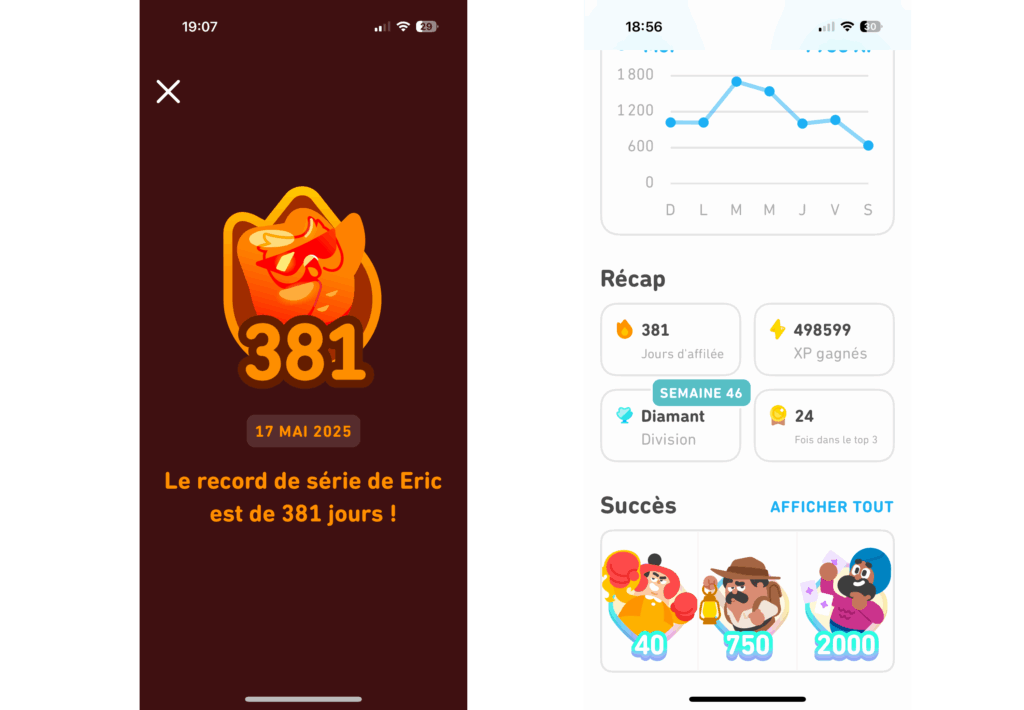Test : My Take on Duolingo Subscription
1. Test Conditions & Background
I tested the Duolingo subscription for one year. To do this:
- I purchased a one-year subscription on the Apple App Store
- I enabled all features and free trial offers
- I enabled all notifications and completed all suggested tasks
- I maximized my subscription by using the app as much as recommended
My Duolingo trial started in May 2024 and includes two weeks of free access. The subscription is handled via the Apple App Store and will end on May 16, 2025, with more than 495,000 points accumulated and a 381-day streak.
I chose to learn Italian as a French person because I am at a beginner level (CLOÉ A2) and I want to maintain my knowledge of the language.
2. The Core Service
Language learning with Duolingo is based on repetition with pronunciation, writing, and word pairing exercises. With this method, no context is provided, and no grammar or conjugation rules are explained.
For example, in Italian, a singular noun ending in ‘o’ becomes ‘i’ in the plural (with some exceptions, of course). This basic rule is not explained at any point.
The increase in difficulty is well done, and the complexity is gradual. The user gradually moves from the present to the past, future, and conditional tenses. Sentences become longer and more complex as the user progresses.
After completing the hundred lessons across the three chapters, Duolingo offers a daily recap, which consists of recycled lessons. There is nothing new after this third chapter. Since the number of sentences in the app is relatively limited, the same sentences often come up.
My opinion:
Duolingo is an excellent way to immerse yourself in a foreign language on a daily basis. At first, you feel like you’re making progress as you learn words, pronunciations, and vocabulary.
However, the lack of explanations for grammar and conjugation makes it difficult to understand why an answer is wrong and limits language proficiency.
Learning by repetition combined with a limited number of sentences leads to knowing answers by heart without needing to read the entire sentence. We’re merely repeating like parrots rather than truly learning.
Conclusion:
- I think you can acquire a superficial knowledge of a language thanks to Duolingo. Therefore, it seems highly unlikely that you’ll be able to truly learn a foreign language from scratch.
- In my opinion, Duolingo is more of a social game that involves learning a foreign language, and not the other way around.
3. Gamification
As explained in my article “Gamification as a Retention Method“, the goal of gamification is to increase engagement. However, engagement is higher among subscribers who renew their subscriptions.
Gamification is Duolingo’s strongest feature, successfully awarding points and bonuses for every action. The user is encouraged to maximize their points through the use of bonuses. Users are encouraged to answer as quickly as possible; coupled with the repetitive nature of the process, they end up typing the answers without having to read the sentences.
Users are kept under pressure as the point award rules are changed several times throughout the year. Users must adapt and develop new optimization strategies.
Badges can be earned for various reasons. Having managed to obtain all the badges before the end of the subscription, I have no reason to continue.
Conclusion:
- The gamification is very well executed. It includes a social dimension with leaderboards. Engagement is maximized. I was encouraged to use the app daily for the entire 365 days.
- The gamification is so present that learning almost becomes secondary.
4. Cross-selling & Up-selling
a. Up-selling:
As a SuperDuolingo subscriber, I was invited to upgrade to the Duolingo Family and Duolingo Max versions on multiple occasions.
At times, my subscription disguised itself as the Max version for a week in an attempt to entice me to upgrade.
The feature being sold in Duolingo Max was conversations with an AI. Unfortunately, the conversations were very limited and uninteresting.
In the free version, the up-selling is far from subtle; it borders on harassment rather than mere repetition. Presumably, it works; otherwise, the frequency of offers would be lower.
b. Cross-selling
It is possible to purchase “gems,” Duolingo’s virtual currency. I didn’t feel the need to buy any since I managed to amass a significant number through the game.
In the free version, users may be tempted to pay to get the few missing points required to stay in a division.
Conclusion:
- In the paid version, the upselling isn’t convincing because the differentiating feature doesn’t justify its value. It’s disappointing.
- In the free version, the upselling is everywhere. The cross-selling to users is well thought out.
Do I Renew or not?
I pay primarily for the main feature: language learning. However, this feature is unfortunately less well executed than the gamification.
For this reason, I won’t be renewing my Duolingo subscription.
However, Duolingo’s quality must be recognized. The interface is neat, the design is beautiful, and the exercises are interesting. It’s easy to integrate into the user community.
Duolingo excels in engagement thanks to its effective gamification. We know that the most loyal subscribers tend to be the most engaged. However, top-notch engagement isn’t enough if the core service isn’t delivered.




